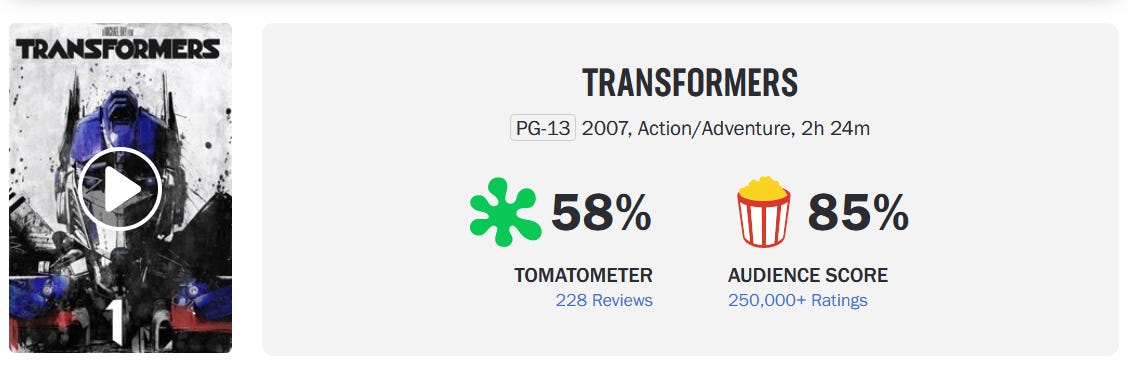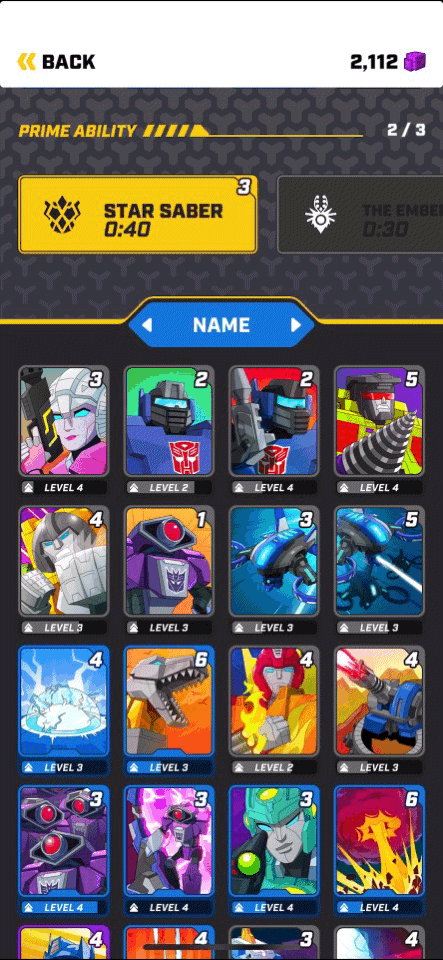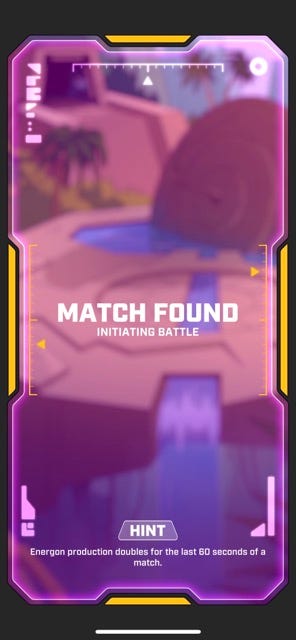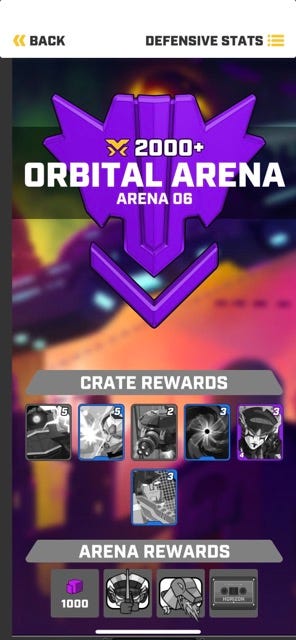When I started this review, I decided to add a fun twist. While I played these games, I would watch every single Transformers movie at the same time. That’s the point of brands right? Full integration. And I wanted to try it out for myself.
Enter The Cybertron-0-verse
So what did I learn watching all of the movies?
That’s… a great question. I’m still emotionally processing it myself.
The best part is that unlike Red Notice it seems I’m on the correct side of history:
But the point of a multi-media brand is to have multiple different ways of interacting with the idea or the thing that the brand represents. For Pokemon it’s collecting, for Marvel it’s having wacky fun with superpowers, for Star Wars it’s lightsabers and space adventures.
For transformers… it’s… and you’re never going to guess: Transforming.
What stood out the most about the movies was just how unimportant transforming was to the movies. This might be an altruistic view but the whole cool thing about transformers is the concept that machines could be in anything. It’s actually a really cool concept. Machines can be anywhere! And they’re friends! But there are some bad ones too, be careful.
The movies end up being a lot of mush about the interplanetary politics of some dude named Megatron and some dude named Optimus Prime and how they relate to humans. For a movie about robots, it was incredibly obsessed with humans. Though they did remember to mention the “more than meets the eye” catchphrase at various points.
Which… to be fair… all of this makes a lot of sense for a medium where showing human faces is actually really important.
… Luckily the game has none of these problems …
The most surprising part of this experience was realizing that Transformers: Tactical Arena is actually a really good game. And I don’t mean in the sense like “if you happen to have Apple Arcade and 5 minutes and nothing better to do”. I mean it’s a good game that might be worth picking up Apple Arcade for.*
*assuming the player-base sticks around
Why is this game good?
The Conceit of the Game is Fun
The short answer is, Clash Royale is a great game and Tactical Arena takes most of the good stuff without adding any of the annoying stuff that games like LEGO Star Wars Battles. It’s the same competitive tower defense formula where you’re launching attacks at your opponent by putting different units on the battlefield and watching them smash into each other.
The biggest challenge of games like these is how easily you can get feedback from the stuff you do. This happens because of a combination of the size of the units, the speed of the game, and the fact that the same units can be at different power levels because of the progression system. Each player also has a special ability they can activate at any time (it’s the same for most people though you can unlock a different one), that acts as a wave clear and can help even out the board if you don’t have the right card in your hand.
But the game also uses the concept of “transformation” in a really smart way. For one thing, some of the main characters transform into cars and speed across the battlefield when they’re not battling enemies. Other, even more powerful, heroes can be played in one of two ways: as either of their transformed modes. In the case of Optimus Prime, his fire truck version costs more but comes with speed and when he crashes into buildings he deals a bunch of damage.
The Art and UI is Great and On Theme
I’m probably more biased here. The art is reminiscent of the show from the late ‘80s and early ‘90s that I grew up watching. But the art style fits really well on a phone and leads to cards and units that clearly show what they do. Beefier units are larger and typically only summon 1 unit when you play them. Cheaper units are smaller, tend to spawn multiples, and exist to swarm the enemies. And different units really feel different. There’s a variety of ranged units, melee units, units that deal splash damage or direct damage. Even when you’re getting overpowered it feels like there’s a counter just around the corner if only you can find it.
The Menu System Feels Smooth and the Progression System Feels Fair
Unlike some other games (looking at you again LEGO Star Wars Battles), there’s really only one way to progress through the game, and that’s by winning battles. Every battle you win, you get a crate that unlocks cards. The cards go towards earning new units or leveling up characters. As you play the game more, you level up, earn more characters and move through new worlds. There aren’t a bunch of gimmicks or things to track. It makes jumping into a new game incredibly easy.
It’s Not Perfect: The Grind
It’s not quite perfect. For one thing, the fact that it’s in Apple Arcade is great because it means there aren’t any unlocks, but it also means that it feels like the game will certainly fade away. There just won’t be enough new players in the game to sustain a thriving competitive scene.
But the main issue is that certain types of characters are only unlocked in certain zones, which can only be reached by winning battles and leveling up. There are good design reasons to structure the game this way. For one, it means that you can set characters at similar power levels and ensure that players of similar skill levels will play against them. This means you don’t have to create a single power level and balance across it. This makes the design easier and a bit fairer for players. There’s no chance someone opens or chooses a unit that’s just way more powerful.
At the same time, it does limit the reach of the game. Each level higher you go the harder it is to reach the next level. It’s just unlikely that I’ll ever make it to the final level and unlock those characters. And that’s rough. Especially for a game I ostensibly paid for. Often it feels with games like these, especially the ones on Apple Arcade, focus way too much on the progression system, and not enough on the fact that they have to make a fun game to play. That’s not the case here. It’s more a case where an otherwise fair progression system doesn’t provide many incentives to continue playing.
There’s no easy solution, but it would be nice to open up the units to more players more quickly. Progression systems tend to be put in place to keep players coming back for more. It’s the overjustification effect in action. If they have a reason to come back, they’ll keep playing the theory goes. But as those external rewards increase, the enjoyment of the game decreases and it makes the grind feel longer and more grueling. It also eliminates one of the main reasons to keep coming back, to try new moves and combos. If you know it will be hours before you get to try something new, what’s the point? It would be nice to see games experiment more with these systems.
The Future of Robot-Kind
The biggest question for Transformers Tactical Arena (and every competitive game on Apple Arcade) is how long will the player-base stick around, and how many updates will it get? It’s a fun game and I hope it continues to see attention from the developers and Apple.











